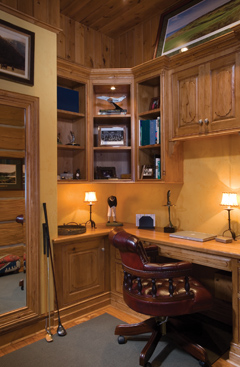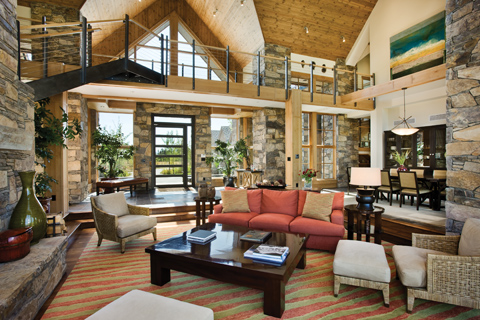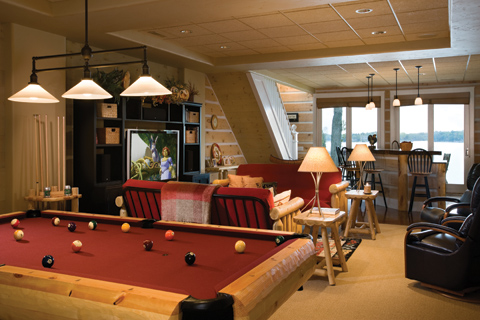The professional consensus on current primary home trends, from differing regions of the country, includes cost-consciousness, sustainability, practicality, and a better-than-ever educated client. These are the overarching trends that will likely be around forever, becoming, as architect Shawn Leatherwood says, “the new norm.”
“It’s a strange time right now,” suggests Leatherwood. “Prospective clients seem to be doing plenty of tire kicking before hiring and buying. People are taking a lot of time to determine exactly what they want, and not moving with the haste they did five years ago.”
So begins a discussion of what is trending in today’s family home. It’s not surprising that the recent recession has resulted in a cautionary approach to home investments. New home buyers, like always, will want to take advantage of exciting market trends but, with a sharpened view toward cost consciousness, extending the length of the design and construction process.
Leatherwood’s firm, The Architectural Studio, is based in Waynesville North Carolina. “We design about 50 percent primary homes and 50 percent second homes,” says Leatherwood, “which frequently become the primary home after retirement, also a rising trend.”
He says the foremost trend, beyond overall cost consciousness, is a desire for quality rather than quantity. With 20 years in the architectural trade, 10 owning his own firm, Leatherwood has noticed a general evolution since the 1990s. “Homes were designed to be larger back then, but with less quality in the craftsmanship. In 2000, people started realizing that smaller homes with higher quality building materials made more sense. During the last few years that trend has risen to a new level.” Many homeowners are planning on handing their homes down from generation to generation, using materials and methods to stand the test of time, building a home to last for 100 to 150 years. The six-bedroom home of the 90s was replaced with a four-bedroom home at the turn of the century, and today a three-bedroom home is the norm, with at least one of the bedrooms serving more than one purpose.
Leatherwood says, “Dual-use space was a hard sell even up to 2006, now it’s the new normal, along with quality in building materials. It’s simple practicality that is driving these trends, which I believe will be lasting. There is a big focus on designing for a family’s lifestyle, now as well as down the road. Today’s home is designed to last and function as a family grows, or shrinks, whichever the case may be.”
 Caribou Creek Log Homes/photo by Roger Wade
Caribou Creek Log Homes/photo by Roger WadeShifting from architectural to interior design, Marsha Jones, an interior designer based in the Chicago area, reports that her recent projects involve homeowners looking to update to more current styles, whether they have purchased a new home or are upgrading their current residence. Jones says the leading interior design trend is a cleaner, fresher look. “It depends on the client, as far as the style goes, anything from all neutral tones to bright colors can work, but there is a focus on mixing old with new, implementing cleaner lines. The serious, dark look is dated. The heavy European look is out. I use the analogy of the fashion styles of the 1890s to the 1920s. Fashion went from stiff heavy fabrics, lots of ruffles, trims, etc. to light, shorter dresses. Home design is evolving in the same manner, from heavy draperies to crisp fabrics with simpler lines. The mix of Danish modern with industrial influence is also strong.”
Jones agrees with Leatherwood’s thoughts on the importance of high-quality interior finishes. “The green, sustainable trend is very important to some of my clients,” she says, “but most of them are more concerned with a great new look that meets their budget. I always try to direct them to classic, timeless designs and finishes that will last much longer, versus using building materials that are too trendy. I suggest indulging in temporary design trends with the use of paint or accessories, which can be changed easily and inexpensively.”
Another trend in primary residences? Home-owners hiring a “team” of professionals to design and construct their homes. Marsha Jones shares, “I have worked on many projects involving a team of industry pros and the result is always a benefit for the client. Everyone gets to work off one another’s creativity, including the homeowner’s, and in the end a more complex and creative product is achieved.”
“Teams are also a piece of the new norm,” adds Leatherwood. “We see a real value in hiring a team of pros. Clients are more willing to go that route now because it actually results in cost savings. Yes, we bounce ideas off each other, but we also keep each other in line. Clients used to not be willing to hire a team, going instead for a competitive all-inclusive bid. Selecting the lowest bidder is not always the best approach.”
A significant interest to Peter Lee, veteran homebuilder and founder of Teton Heritage Builders, is the trend toward energy efficiency in primary homes. “A few years ago,” says the builder, “I started a small sister company that retrofits existing homes with new geothermal heating systems. The resulting energy savings in these homes have been amazing. I’ve also been steering clients on new home construction toward investing in the systems. Once a discussion of different types of energy efficient systems and equipment begins, some really exciting design/build elements can take place.” Lee sites a recent project that not only utilized geothermal heating, but solar-powered hot water heat as well, and a thermal envelope of beefed-up insulation, boasting R70 in the ceilings. Another project, although not a modest house in scale, was designed and built with a lengthy thought process as to how native materials from the home site could be used in the building. “This was the most eco-friendly home we have built to date,” says Lee. “Our client was committed to making the smallest carbon footprint as possible on his property. We won an NAHB Green Bronze Award Certification for the project.”
Perhaps this is the most exciting and important trend in today’s home design: an increased sensitivity to the environment. Architects and builders are syncing up with ancient building techniques using onsite bio-degradable materials. Comfortable, economical, and rustically beautiful dwellings are resulting from the efforts to protect the environment. Furthermore, new buildings are increasingly incorporating reclaimed, or repurposed, older structures imported from offsite locations.
Lee sees eye to eye with both Jones and Leatherwood on the trend toward simple, cleaner lines in home design. “The theme is running strong in Jackson Hole and Big Sky,” the builder claims. “It’s been developing for a while, a huge departure from the former norm in the northern Rocky Mountain region. The thing is, it’s not new! I recognize the style as a return to the design sensibility of the 1970s, when architects were fighting the boundaries of the materials available to them to make these sorts of structures work. In the last 40 years the technology has moved forward tremendously, so now it becomes practical to design and build in the mountains with lowpitched or even flat rooflines, and massive banks of triple-pane glass. It has become more affordable, trouble free, and energy efficient.”
Additional primary home trends include elements of Universal Design, such as wider hallways and doorways, ramp access to entries, and elevator shaft space. These features may become necessary as a family grows with a home.
NAHB reports that new family homes are being designed with plenty of space for family interaction in areas like the kitchen, while eliminating formal living and dining rooms, and home offices that are underutilized. The popularity of “pocket offices” is on the rise, often in the great room or even large pantries. Homes with two master suites are trending, frequently on separate floors for multigenerational occupancy.
Yards and gardens are increasingly becoming a part of floorplan design. Outdoor “rooms” might include sophisticated kitchens with sinks, grills and plenty of counter and storage space, perhaps further evidence of the trend toward recognition and enjoyment of the environment.
Photography by Roger Wade Studio


